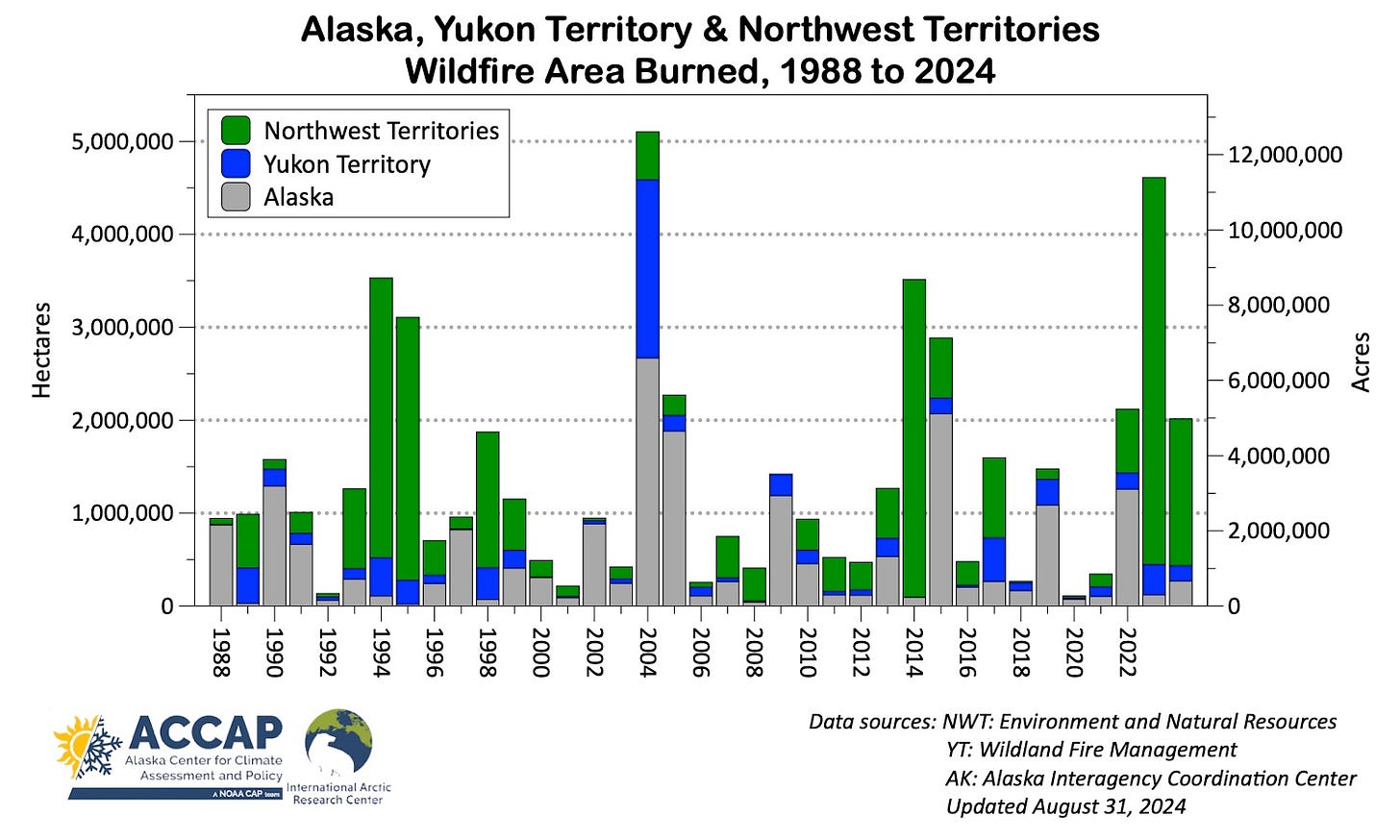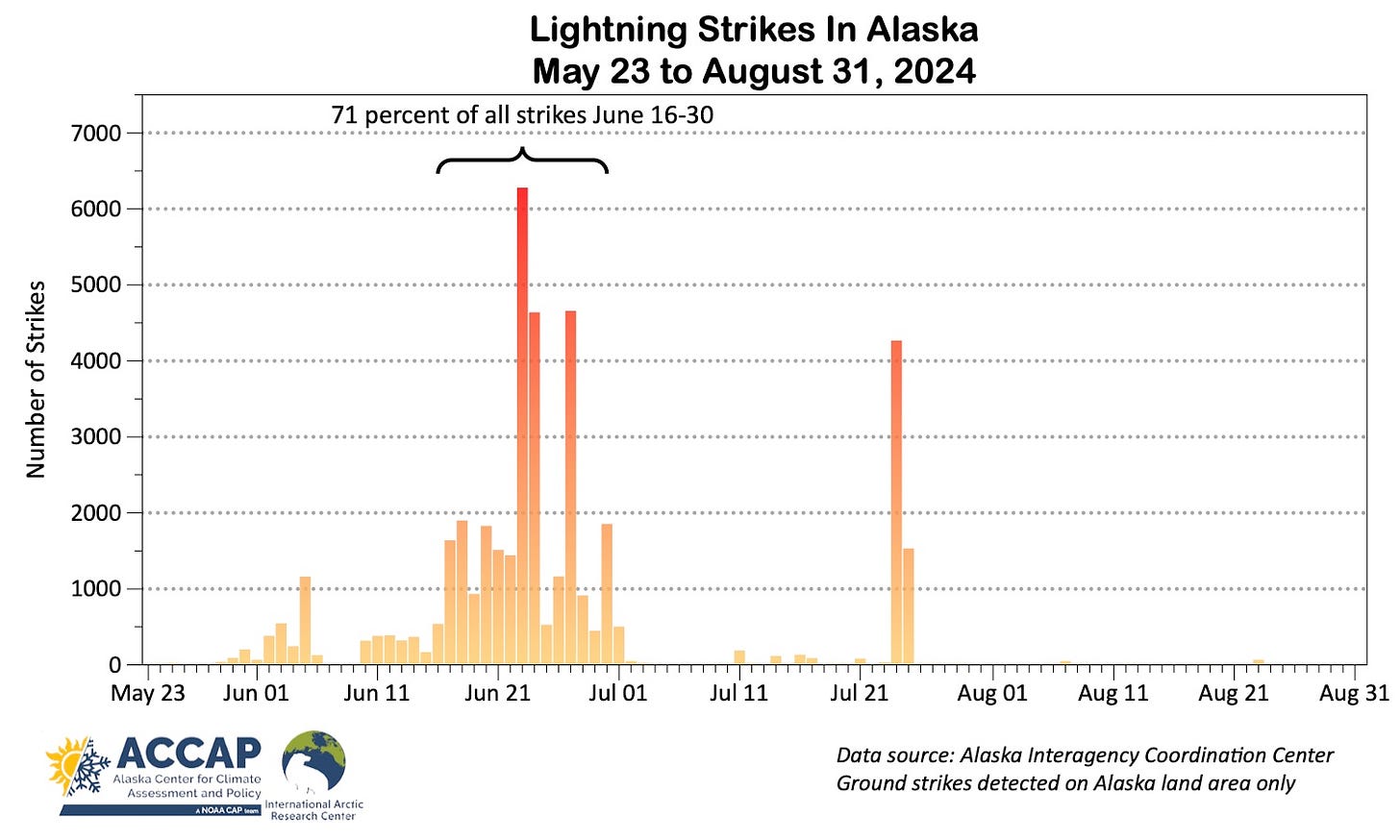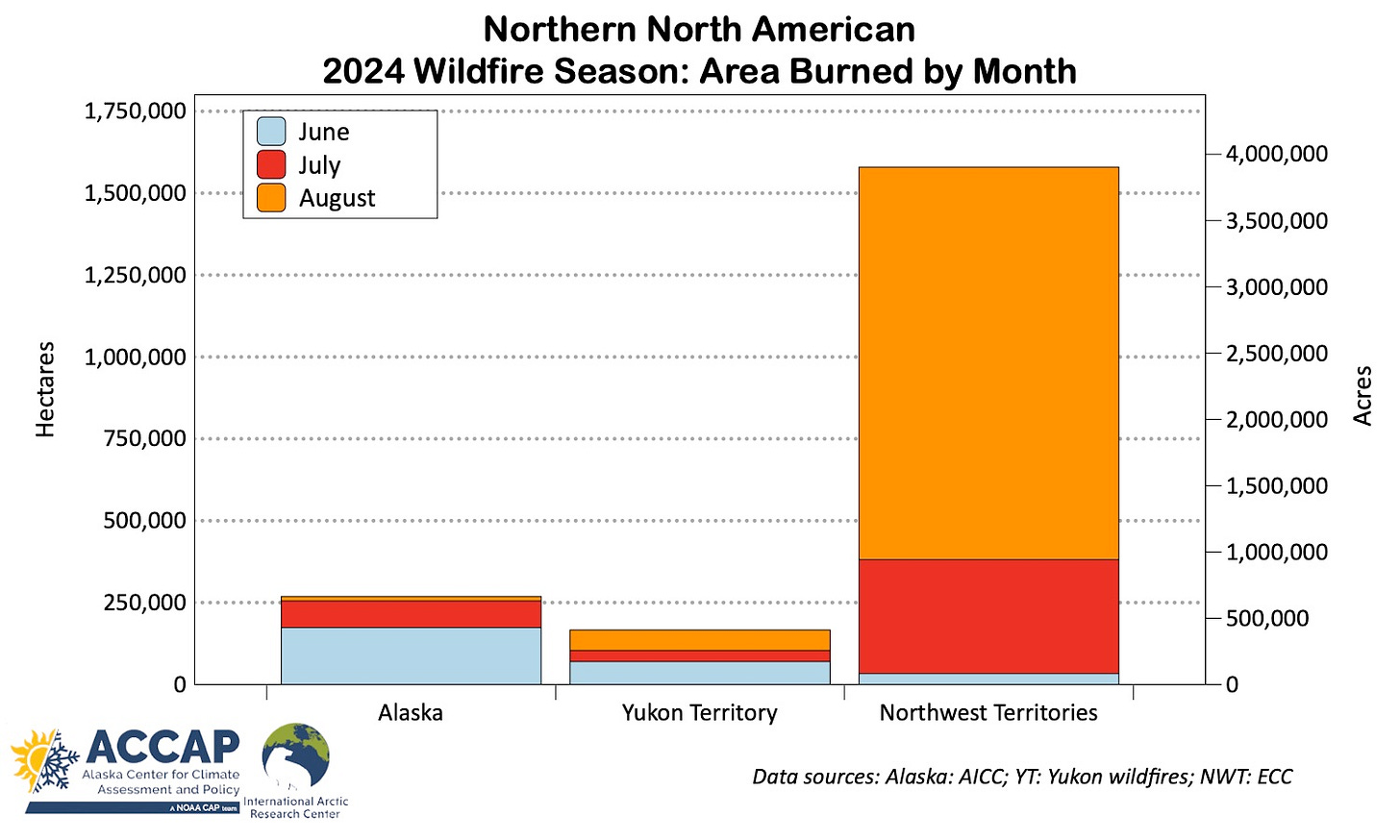The northern North American wildfire season is mostly complete, though as often happens, some fires will persist into September in the southern Yukon and Northwest Territories.
The total area burned in 2024 wildfires in Alaska, the Yukon Territory and the Northwest Territories was about 2,014,000 ha (4,978,000 acres). This is more the twice the median of the preceding 35 years but less than half of the 2023 near-record season. This was almost entirely the result of the less wildfire in the Northwest Territories. Figure 1 plots the area burned for each year since 1988 for each jurisdiction.

The 2024 wildfire season started off more active in the west (Alaska) than in the east (NWT), but a change in the weather pattern in early July flipped the table, with minimal wildfire in Alaska after mid-July, while the NWT burned more than two-thirds of the total area during August. Unsurprisingly, the Yukon Territory split the difference, with a roughly equal area burning in the three summer months.
Canada Wildfires
The 2024 wildfire perimeters for northwest Canada are shown in Fig. 3. In the Yukon Territory, the Wrong Lake Wildfire complex north of Pelly Crossing burned 16,900 ha and intermittently closed the North Klondike Highway in late June and early July. North of the Alaska Highway, east of Beaver Creek, the Snag Lake wildfire was the largest in the Yukon in 2024 at just under 50,000 ha (123,000 acres) and the nearby Donjek fire burned over 11,000 ha (27,400 acres). Both these fires started in early June and burned through the summer. The Snag Lake fire burned three cabins at Kluane Wilderness Lodge on Wellesley Lake the third week in August and was still producing significant smoke at the end of the month.
The 2024 wildfire season in the Northwest Territories was not as extreme as 2023 but was still very impactful. The largest fires were south and west of Great Bear Lake , with FS011 at over 217,000 ha (536,000 acres) and VQ010 over 144,000 ha (356,000 acres) as of August 31, but several fires in the South Slave district kept crews busy, with impacts to travel on Highway 1 between the Alberta border and Enterprise. While Yellowknife saw episodes of smoke, there were no large wildfires near the capital city.
In the Sahtu region in the middle Mackenzie valley, Fort Good Hope was evacuated June 15 as fire VQ001 threatened. The fire eventually burned nearly 9,000 ha (22,000 acres) and burned right to the edge of town: residents were not able to return until early July. In August, Délı̨nę (west end of Great Bear Lake) was also partially evacuated due to threats from VQ010 and VQ011.
Alaska Wildfire
As sometimes happens, the Alaska wildfire season was very compressed: 75 percent of the seasonal area burned occurred in the three weeks between June 19 and July 9. The short but sharp heatwave in July 20-25 produced an increase in wildfire activity, mostly in the eastern Interior, but acreage gains were modest. Figure 4 plots the 2024 wildfire perimeters in Alaska. The wildfire activity was not quite as concentrated in the central Interior as in July and August 2023, but big fires both north and south of Fairbanks brought significant smoke to the Golden Heart City in late June and early July, and for the third consecutive summer there were more than 100 hours of smoke dense enough to cause significant visibility restriction and prolonged poor air quality, and on June 30, for the first time since August 2005, visibility at the Airport was reduced for a couple of hours to one-quarter mile.

The McDonald Fire, on the Tanana Flats southeast of Fairbanks, was the largest fire in Alaska in 2024, burning 153,000 acres (61,900 ha). However, the McDonald Fire engulfed the originally separate Clear Fire (23,000 acres, 9,300 ha) and Meridian fire (3 acres, 1 ha), so the total area burned was 176,781 acres (71,541 ha), making this the largest wildfire within Fairbanks North Star Borough since the terrible summer of 2004.
The human-caused Riley fire on the west side of Nenana River at Denali National Park started June 30, and although held to less than 450 acres (180 acres) through rapid response by the Alaska Fire Service, it caused significant disruptions for Park visitors and staff for a couple of weeks.
The total 2024 wildfire burned in Alaska of 664,000 acres (269,000 ha) is very close to the time-varying median (Fig. 5). The increased frequency of big wildfire years is well known, both within Alaska and around the boreal Arctic, but the typical seasonal acreage is also increasing and has more than doubled in the past 75 years.

Lightning started wildfires account for the vast majority of area burned in the North, and in Alaska, 2024 was an uneventful lightning season. Based on the Alaska Fire Service’s Lightning Detection Network, only one day (June 23) had more than 5,000 strikes and the seasonal total was only around 45,000 strikes, far less than usual. And of that total, 71 percent occurred in the second half of June, while July, often the month with the highest amount of lightning, had appreciable thunderstorm activity on only two days.







What explains the 10 year cycle of highest wildfire activity shown in Fig 1. ?
For a boots on the ground view of the Canadian boreal fires of 8 years past, read Vaillant's great Fire Season book that came out last year. It's stunning.